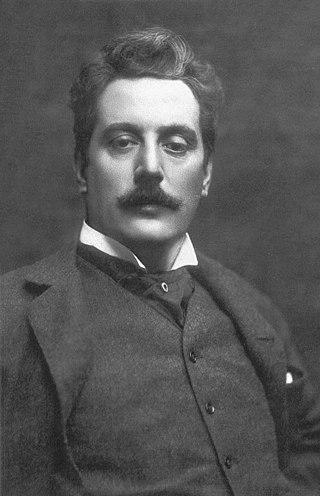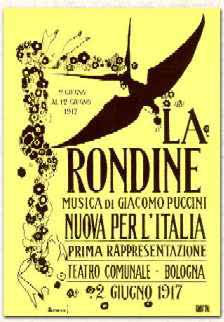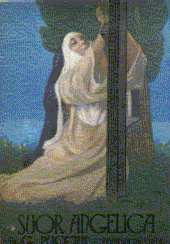
Giacomo Puccini was an Italian composer known primarily for his operas. Regarded as the greatest and most successful proponent of Italian opera after Verdi, he was descended from a long line of composers, stemming from the late-Baroque era. Though his early work was firmly rooted in traditional late-19th-century Romantic Italian opera, he later developed his work in the realistic verismo style, of which he became one of the leading exponents.

La bohème is an opera in four acts, composed by Giacomo Puccini between 1893 and 1895 to an Italian libretto by Luigi Illica and Giuseppe Giacosa, based on Scènes de la vie de bohème (1851) by Henri Murger. The story is set in Paris around 1830 and shows the Bohemian lifestyle of a poor seamstress and her artist friends.

Madama Butterfly is an opera in three acts by Giacomo Puccini, with an Italian libretto by Luigi Illica and Giuseppe Giacosa.

Turandot is an opera in three acts by Giacomo Puccini to a libretto in Italian by Giuseppe Adami and Renato Simoni. Puccini left the opera unfinished at the time of his death in 1924; it premiered in 1926 after the music was posthumously completed by Franco Alfano.

The Monk: A Romance is a Gothic novel by Matthew Gregory Lewis, published in 1796. A quickly written book from early in Lewis's career, it was published before he turned twenty. It is a prime example of the type of Gothic that specialises in the aspect of horror. Its convoluted and scandalous plot has made it one of the most important Gothic novels of its time, often imitated and adapted for the stage and the screen.

Salome, Op. 54, is an opera in one act by Richard Strauss. The libretto is Hedwig Lachmann's German translation of the 1891 French play Salomé by Oscar Wilde, edited by the composer. Strauss dedicated the opera to his friend Sir Edgar Speyer.

Dialogues des Carmélites, FP 159, is an opera in three acts, divided into twelve scenes with linking orchestral interludes, with music and libretto by Francis Poulenc, completed in 1956. Poulenc wrote the libretto for his second opera after the work of the same name by Georges Bernanos. This is a fictionalized version of the story of the Martyrs of Compiègne, Carmelite nuns who, in 1794 during the closing days of the Reign of Terror during the French Revolution, were guillotined in Paris for refusing to renounce their vocation.

Manon Lescaut is an Italian-language opera in four acts composed by Giacomo Puccini between 1889 and 1892 to a libretto by Luigi Illica, Marco Praga and Domenico Oliva, based on the 1731 novel Histoire du Chevalier des Grieux, et de Manon Lescaut by Abbé Prévost. The opera was first performed in 1893 in Turin, at the Teatro Regio.

Il trittico is the title of a collection of three one-act operas, Il tabarro, Suor Angelica, and Gianni Schicchi, by Giacomo Puccini. The work received its world premiere at the Metropolitan Opera on 14 December 1918.

La Rondine is an opera in three acts by Giacomo Puccini to an Italian libretto by Giuseppe Adami, based on a libretto by Alfred Maria Willner and Heinz Reichert. It was first performed at the Grand Théâtre de Monte Carlo in Monte Carlo on 27 March 1917.

Le Villi is an opera–ballet in two acts composed by Giacomo Puccini to an Italian libretto by Ferdinando Fontana, based on the short story "Les Willis" by Jean-Baptiste Alphonse Karr. Karr's story was in turn based in the Central European legend of the Vila, also used in the ballet Giselle. The opera, in its original one-act version, premiered at Milan's Teatro Dal Verme, on 31 May 1884.

Ave Maria Ninchi was an Italian supporting actress who played character roles on stage, television, and in over 98 feature films that included Tomorrow Is Too Late (1949) and Louis Malle's Murmur of the Heart (1971) and Lacombe, Lucien (1974).

The Mists of Avalon is a 2001 television miniseries based on the 1983 novel of the same title by Marion Zimmer Bradley. Produced by American cable channel TNT, adapted by Gavin Scott, and directed by Uli Edel, the series is a re—telling of the Arthurian legend with an emphasis on the perspectives of Morgan le Fay and other women of the tale. The first episode was the highest-rated original movie on basic cable in the summer of 2001.

Charlotte of Bourbon was a Princess consort of Orange as the third spouse of William the Silent, Prince of Orange, the main leader of the Dutch revolt against the Spanish. She was the fourth daughter of Louis III de Bourbon, Duke of Montpensier and Jacqueline de Longwy, Countess of Bar-sur-Seine.

Mese mariano is an opera in one act by Umberto Giordano. Its Italian libretto by Salvatore Di Giacomo was adapted from his play 'O Mese Mariano, which was in turn adapted from his novella, Senza vederlo. It premiered at the Teatro Massimo in Palermo on 17 March 1910. The opera is described as a bozzetto lirico and has a running time of 35 minutes. It tells the story of a woman who visits an orphanage to see her child. Racked with guilt at having abandoned him, she is unaware that he had died the night before.

The Saint of Bleecker Street is an opera in three acts by Gian Carlo Menotti to an original English libretto by the composer. It was first performed at the Broadway Theatre in New York City on December 27, 1954. David Poleri and Davis Cunningham alternated in the role of Michele, and Thomas Schippers conducted. It ran for 92 consecutive performances.
Amanda Juliet Holden was a British pianist, librettist, translator, editor and academic teacher. She is known for translating opera librettos to more contemporary English for the English National Opera, and for writing new librettos, especially in collaboration with Brett Dean. She contributed to encyclopedias such as the New Penguin Opera Guide.
Dream of the Red Chamber is an English-language opera in two acts composed by Chinese American composer Bright Sheng, with libretto by Sheng and David Henry Hwang. Based on the classic 18th-century Chinese novel of the same name by Cao Xueqin, the three-hour English-language opera had its world premiere on September 10, 2016, by the San Francisco Opera. The opera was reprised by the San Francisco Opera in June 2022.
Janis Kelly is a Scottish operatic soprano and voice teacher. She is Professor and Chair of Vocal Performance at the Royal College of Music in London.
Marie Mattfeld was a German opera singer who performed repertoire from the mezzo-soprano and soprano canon of performance literature during the last decade of the 19th century and the first three decades of the 20th century. Beginning her career performing in concerts and operas in Munich in the early 1890s, she joined Walter Damrosch's newly created American opera company in 1896. After performing for several years in operas in the United States, she returned to Germany where she was committed to Theater Bremen from 1901 to 1905. In 1906 she returned to the United States to join the roster of resident artists at the Metropolitan Opera ; having previously made her debut with that company in 1901. She remained committed to the Met up until her death in 1927; giving a total of 900 performances in more than forty different operas. She was particularly admired for her portrayal of Hänsel in Engelbert Humperdinck's Hansel and Gretel.


















